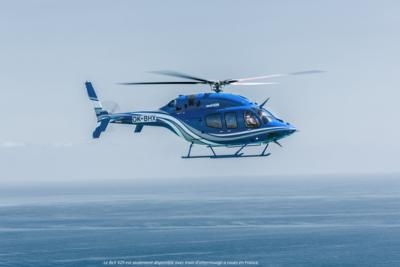Tue, Feb 14, 2017
Third Consecutive Year For A Drop In Overall Helicopter Accident Rate
The U.S. helicopter accident rate and the fatal helicopter accident rate have fallen for the third consecutive year, according to FAA data.

The overall accident rate fell to 3.19 accidents per 100,000 flight hours in 2016 compared with 3.67 accidents in 2015. The fatal accident rate fell slightly to 0.51 accidents per 100,000 flight hours in 2016 compared with a 0.52 rate in 2015. However, the rate is down from 0.65 in 2014 and 1.02 in 2013.
In raw numbers, there were 106 helicopter accidents in 2016, including 17 fatal accidents. That is a 12 percent decrease compared to the previous year and a 27 percent decrease compared to 2013.
“The FAA and the helicopter industry have worked together to educate the civil helicopter community about safe practices, to drive these improved results,” said FAA Administrator Michael Huerta. “The FAA and the industry also are taking an active role in advancing safety through new technology, collaborative policy changes and proactive outreach.”
The FAA and the helicopter industry have worked together through groups such as the International Helicopter Safety Team and the U.S. Helicopter Safety Team to prevent accidents. The effort is achieving success through a series of proactive measures:
- Creating a culture of safety – The FAA has encouraged helicopter companies and individual pilots to promote safety in the workplace. Efforts include establishing a system where anyone can report an unsafe condition without fear of reprisal, making every employee a champion of safety, and establishing safety training programs for mechanics, pilots and other employees.
- Cutting the red tape – The FAA issued the Non-Required Safety Enhancing Equipment policy in 2013 after consultations with industry. The policy allows operators and manufacturers to install safety equipment through a streamlined and less expensive approval process. The policy seeks to strike a balance between risk and safety through a “common-sense” approach.
- New technology – Both the FAA and industry are using technological advances to promote safer helicopter flights. For example, the FAA mandated that the Automatic Dependent Surveillance Broadcast system (ADS-B) be installed in U.S. helicopters by Jan. 1, 2020 if they intend to operate in busy airspace. ADS-B’s satellite-based technology can provide three-dimensional information (latitude, longitude, altitude) about a helicopter’s position, along with information about its direction and size, without the geographic drawbacks posed by radar.
- Collaborative rule-making – The FAA is working with industry representatives to ensure that newly-manufactured helicopters can help prevent injuries, post-crash fires and catastrophic damage from bird-strikes. Some manufacturers and operators are already voluntarily stepping up and installing the life-saving equipment. In addition, the FAA required in 2014 that certain (Part 135) commercial helicopter operators, including air ambulances and air taxis, have stricter flight rules and procedures, improved communications, training, and additional on-board safety equipment.
- FAA International Rotorcraft Safety conference – For the past two years, with industry’s support the FAA has hosted a three-day gathering focused on a variety of safety topics. The conference includes presentations about decision-making, fatigue, safe autorotations, protective equipment, a culture of safety, and first-person experiences.
(Source: FAA news release. Image from file)
More News
Runway Lead-in Light System Runway Lead-in Light System Consists of one or more series of flashing lights installed at or near ground level that provides positive visual guidance a>[...]
Aero Linx: Aviation Without Borders Aviation Without Borders uses its aviation expertise, contacts and partnerships to enable support for children and their families – at hom>[...]
Dave Juwel's Aviation Marketing Stories ITBOA BNITBOB ... what does that mean? It's not gibberish, it's a lengthy acronym for "In The Business Of Aviation ... But Not In The Busine>[...]
From 2010 (YouTube Version): Yeah.... This IS A Really Cool Job When ANN's Nathan Cremisino took over the lead of our Aero-TV teams, he knew he was in for some extra work and a lot>[...]
Also: Junkers A50 Heritage, Montaer Grows, Dynon-Advance Flight Systems, Vans' Latest Officially, the Carbon Cub UL and Rotax 916 iS is now in its 'market survey development phase'>[...]
 ANN's Daily Aero-Term (04.24.24): Runway Lead-in Light System
ANN's Daily Aero-Term (04.24.24): Runway Lead-in Light System ANN's Daily Aero-Linx (04.24.24)
ANN's Daily Aero-Linx (04.24.24) Aero-FAQ: Dave Juwel's Aviation Marketing Stories -- ITBOA BNITBOB
Aero-FAQ: Dave Juwel's Aviation Marketing Stories -- ITBOA BNITBOB Classic Aero-TV: Best Seat in The House -- 'Inside' The AeroShell Aerobatic Team
Classic Aero-TV: Best Seat in The House -- 'Inside' The AeroShell Aerobatic Team Airborne Affordable Flyers 04.18.24: CarbonCub UL, Fisher, Affordable Flyer Expo
Airborne Affordable Flyers 04.18.24: CarbonCub UL, Fisher, Affordable Flyer Expo



